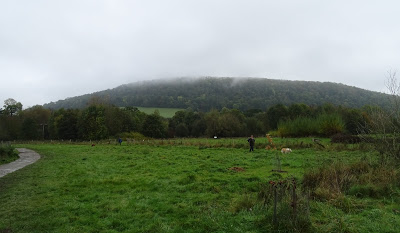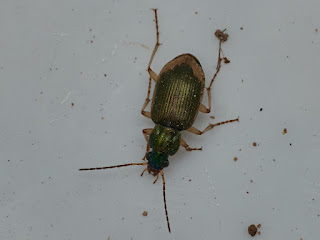Wednesday 25th October 2023, Shropshire Hills Discovery Centre
Before I write anything about our visit to the Discovery Centre I would like to show you this photograph of a collection of ducks on Priorslee Lake in Telford.
 |
| Photograph: David Williams |
This photograph was taken with a mirror lens and demonstrates the Doughnut Bokeh effect.
Use your web browser tools to open the photograph in a new window and look at the darker background at the top of the photograph. What should be highlights caused by light on the darker ripples are captured in the photograph as a series of bright circles. This is an example of the Doughnut Bokeh effect.
For the record the ducks are (from left to right) a female Scaup, male Pochard, female Velvet Scoter and a bit of a male Tufted Duck.
My thanks to David for supplying the photograph and the simple explanation.
Back to the Discovery Centre.
Conditions were misty as we travelled to the Centre but, thankfully, it was clear by the time we arrived. However, the ground was very damp underfoot and it took until the afternoon for the sun to put in an appearance.
The day before I was contacted by a member of the group who had noticed a social media message stating that the Centre had been flooded. Cue email to the Centre to check!
With some relief they responded that the flood waters had receded and that the grounds although wet were firm underfoot.
The visit went ahead as planned.
We assembled in the car park and then wandered into the grounds. We had not ventured very far when we came across a picnic table and this became the focus of attention as we used it to look through samples from forays into the vegetation.
Early finds included this spider, Nigma walkenaeri;
 |
| Photograph: David Williams |
And this pair of inconspicuous ladybirds, Rhyzobius litura (on the left) and Rhyzobius chrysomeloides on the right.
 |
| Photograph: David Williams |
This photograph proved very hard to achieve as the two ladybirds seemed to take umbrage whenever they were placed together and scuttled further apart. Many attempts were unsuccessful and this elicited many sounds of exasperation, but success in the end.
As the site had been flooded, we were keen to look at any debris that had been deposited on the site. To this end we moved swiftly through the grassland to get closer to the river.
We did not quite make it, pausing at the side of the large pool. Around this area we found a 24-spot ladybird;
 |
| Photograph: David Williams |
And a Bishop’s mitre.
 |
| Photograph: David Williams |
However, we also found some deposits from the flood caught up in the vegetation.
This was sampled into a tray and its contents examined using a conveniently located stone as a table.
Carrying on we reached the grassland at the side of the River Onny.
Curious I meandered over to the river bank and took a look at the state of the river. It was flowing quickly but was well down from the top of the banks.
There was much more evidence of the flood here with lots of piles of debris littering the grassland.
Finds in this area included a Spiked shieldbug;
 |
| Photograph: David Williams |
A Water measurer;
 |
| Photograph: John Martin |
And a ground beetle Clivina fossor.
 |
| Photograph: John Martin |
It was THAT time and as there was another convenient picnic table we occupied it and the ground surrounding it to have our lunch.
Unfortunately I had to take my leave after lunch as I had an appointment elsewhere but the group carried on. I have no idea what they got up to but I have been sent some photographs…
Of insects that they found.
A beetle, Oulema obscura;
 |
| Photograph: John Martin |
A leaf beetle, Galerucella lineola;
 |
| Photograph: John Bingham |
A rather bedraggled looking Scarlet tiger moth larva;
 |
| Photograph: John Bingham |
And a second Scarlet tiger larva. (I assume it’s another, otherwise the photographer did an excellent job cleaning it up.)
 |
| Photograph: David Williams |
A tortoise beetle, Cassida vibex;
 |
| Photograph: John Bingham |
And a Large yellow underwing moth larva.
 |
| Photograph: David Williams |
What I do know of the afternoon activities is that the group made a visit to the café for tea and cake before packing up for the day.
I am not jealous! …
Maybe just a little.
My thanks to Grow, Cook and Learn, the charity that manages the site, for permitting us to do what we enjoy doing and to the photographers for sending me their images to illuminate the report.








































.jpg)



.jpg)

.jpg)




















